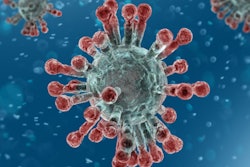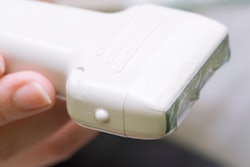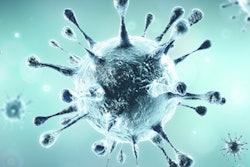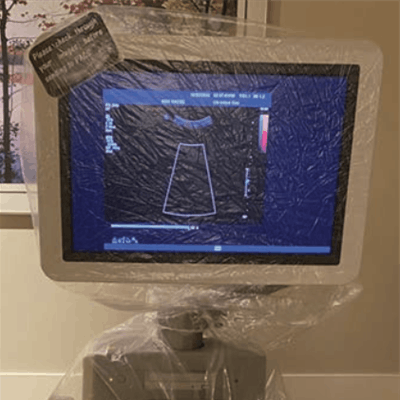
Protocols for staff separation, strict guidelines, and mental healthcare developed to combat severe acute respiratory syndrome (SARS) have helped ultrasound providers at a hospital in Singapore safely respond to the COVID-19 pandemic, according to a June 10 study in the American Journal of Roentgenology.
After SARS swept through Singapore in 2003, the country created a number of protocols to protect healthcare staff, patients, and the general public in the event of another infectious disease outbreak. Radiologists from Singapore General Hospital shared their insights on the measures their ultrasound team members use to care for patients with and without COVID-19.
"Because of the nation's previous encounter with SARS, general infection control measures have become ingrained in the psyche of all staff, and compliance rates are usually maintained well over 90%," wrote the authors, led by Dr. Apoorva Gogna, a senior consultant radiologist.
Scans for patients with COVID-19
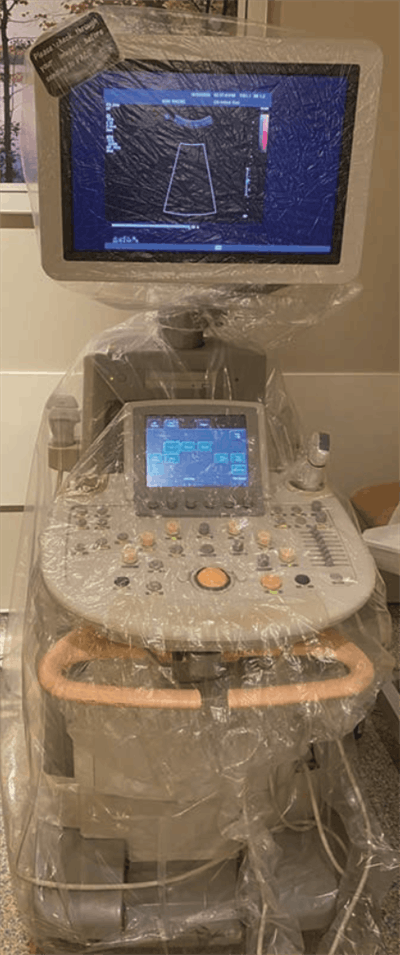 Protective draping used during ultrasound scans. All images courtesy of American Roentgen Ray Society.
Protective draping used during ultrasound scans. All images courtesy of American Roentgen Ray Society.Singapore General Hospital tries to limit the movement of patients with COVID-19 throughout the hospital. This is especially crucial because Singapore isolates all people who test positive for COVID-19 at hospitals until they are no longer infectious.
For the ultrasound team, the isolation guidance means performing scans entirely at patients' bedsides. The hospital also requires attending physicians to communicate with attending radiologists to ensure both that an ultrasound scan and that it will provide specific, clinical answers relevant to the patient's treatment.
Any nonurgent ultrasound scans are postponed until the patient is no longer infectious. But if an ultrasound scan is deemed necessary, both a sonographer and the radiologist on duty don personal protective equipment (PPE) and conduct the scan together. The ultrasound scanner is also covered with disposable plastic draping.
"Although a radiologist and sonographer unit working in tandem substantially reduces throughput, it is a necessary sacrifice to ensure that there will be no need to repeat the scan or obtain extra images," the authors wrote.
Steps are also taken to reduce the time of the ultrasound scan, such as only scanning the iliac and femoral artery segments when looking for deep vein thrombosis (DVT) and stopping immediately if a clot is found. Furthermore, color and Doppler sequencing are only used for problem-solving, and image upload, labeling, and measurements are performed after leaving the ward.
Other precautions
The institution has also established a number of protocols for ultrasound procedures in patients not suspected of having COVID-19. For instance, procedures are prioritized by urgency, and patients undergoing outpatient procedures are limited to one visitor during a scan.
For inpatient scans, patients are also vetted for COVID-19. Those who are not suspected of having the novel coronavirus disease are transferred to a dedicated imaging facility along predetermined routes. A radiologist and sonographer perform bedside ultrasound scans for patients who cannot be moved.
In addition, facilities encourage social distancing by limiting the available chairs in waiting rooms and conducting meetings and training sessions online. The hospital also groups ultrasound staff members by work location or shift time, then tries to keep the groups separated from each other to minimize the risk of COVID-19 transmission should a staff member become infected.
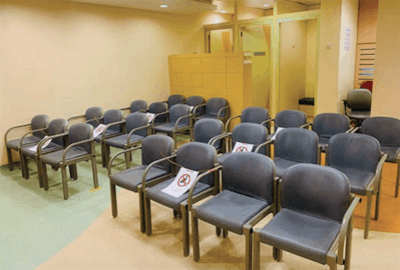 Seating changes to encourage social distancing.
Seating changes to encourage social distancing.Finally, the hospital has taken action to address the mental health of its radiology staff, as some studies in Singapore found up to 40% of healthcare workers experienced symptoms of post-traumatic stress disorder (PTSD) in the years following the SARS outbreak. COVID-19 mental health services include emotional health counseling, providing pantry goods, and facilitating tokens of gratitude from the community.
"The psychologic impact on healthcare employees can be significant during epidemics and can persist or manifest many years later," the authors wrote. "At the department level, the Radiological Science Office of Staff Experience plans a vital role in looking after the welfare of the entire radiology team."




